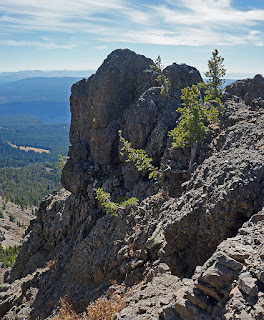
 From the summit I could see most of Yellowstone Park and looked
into the world’s largest caldera. It
doesn’t look like the caldera of Kilauea on Hawaii or any other volcano. In fact it was only recently identified as a
volcano. Because it is so big, it’s
called a super volcano, capable of eruptions dwarfing anything ever seen by
humanity. The most recent, 640,000 years
ago, was a thousand times the blast of the Mount St. Helens in 1980.
From the summit I could see most of Yellowstone Park and looked
into the world’s largest caldera. It
doesn’t look like the caldera of Kilauea on Hawaii or any other volcano. In fact it was only recently identified as a
volcano. Because it is so big, it’s
called a super volcano, capable of eruptions dwarfing anything ever seen by
humanity. The most recent, 640,000 years
ago, was a thousand times the blast of the Mount St. Helens in 1980.
Most volcanoes spew where tectonic plates rub together. Yellowstone’s supervolcano is unusual in
being in the middle of a plate. Most of
these kind are in the middle oceanic plates.
Yellowstone is very rare, being on land called the North American Plate.
Since the last eruption, the caldera has risen 2,000 feet due
to an upwelling of magma below the earth’s crust. Some experts think this forshadows another
eruption. Ironically, rising land due to
hot magma led to colder air. About 20,000
years ago,Yellowstone was under about 4,000’ of glacial ice. Cold ice because of hot magma.

Breccia, volcanic rock from past eruptions.









Hey Sharon! Love, love, love your photographs and dialogue. You are our very own Wild! woman...What a contrast between the thermal energy and the cold air, the volcanic activity and the ice age. Like us, the earth and her processes are a mass of contradictions that push and pull.
ReplyDeleteIt's a poetic irony that hot magma causes cold ice. Yes Kathy, like us, the earth and her processes hide contradictions. What a pleasure it is to see some of them first hand, to be where it's happening, to see inside.
DeleteDear Sharon - I caught up with you this evening . . . Bicycle and car have their differing subjective speeds, but internet is fastest! What a hike you had today. Thank you for the pictures. Thank you for the journey, so far. Janet
ReplyDeleteI have three Janets on my email list. Let me guess - Janet Stone? Nice to see you here.
DeleteThanks for sharing, Sharon. Truly inspirational views and landscape. I don't think we give Yellowstone enough credit. I hope to visit before the next eruption...
ReplyDeleteIt's like being near hell, Kathleen: sulfur in the air, rumbles underfoot, sounds of spray and gurgle. But true hell will be when it erupts again. Maybe you'd better come quickly.
DeleteHi Sharon, Your comments are fascinating, and I love learning from your enviable geological knowledge. Mary J.
ReplyDeleteRocks are fun to figure out, Mary. You might say I rock, but that can be taken wrong. Nice to have you following along here.
DeleteSprays and gurgles and sulfur in the air
ReplyDelete... sounds like Hell's lions and tigers and bears
OH MY
As someone who studied geology, I appreciate your pictures and observations on the potentially explosive nature of Yellowstone as a huge volcanic caldera. But if you think volcanoes are going to blow they don't. They do it when you don't think they will. Most said Mt. Saint Helens wouldn't explode. Lee Collins
ReplyDeleteHello Lee ~ I'm certain you have a poem to enhance your comment ... if not, then one is about to erupt ... when least expected
DeleteYes Lee, I do not predict volcanic eruptions or earthquakes. I leave that the the mutterings of dogs. We have several theories about the hot spot under this caldera. When it blows again and most of the U.S. is under ash and lava, those who remain will have a better theory.
DeleteYes Junnie, he should erupt in poetry. The magnitude of this impending visit from the bowels of the earth deserves the most devilish words. Maybe Lee is too gentle and we'll have to do it.
very exciting and inspiring adventures, Sharon!
ReplyDeleteShow me how inspiring, Kath. Jut upward into the sky like Mt. Washburn does. Maybe spew a bit of lava.
ReplyDelete